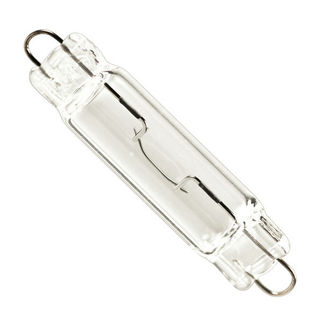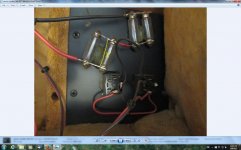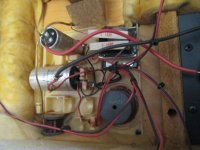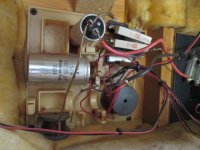Will a 12v.5Watt,car bulb be enough to handle the overload for a Yamaha S250X? The label on the back of the speaker says Noise-125W, Program-250W. Max-500W. I had some advice on this but Im not sure if he realized it was a big powerful speaker or not because he didnt reply? I want to be sure about this because its not my speaker and I dont want it damaged.It has 4 bulbs of unknown value and one is blown.Ive marked it in the photo.Ive soldered a 1 amp fuse across the blown bulb for now.
Attachments
Can you desolder a good one and read whats on the metal cap? Or put 12v through it with an ammeter in series and measure the hot current?
Can you desolder a good one and read whats on the metal cap? Or put 12v through it with an ammeter in series and measure the hot current?
Ive taken the speaker back to him with the 1 amp fuse soldered across the blown bulb? I checked the other speaker while I was there,its stock standard except for both of the 15w tweeter resistors in the crossover are 6.8 ohms,one of them is supposed to be 4.3 ohms according to the specs? The other speaker is the same but it doesnt have the bulbs in series like this one? It doesnt have any bulbs at all because its stock. He seems to be busy and in a hurry all the time so I didnt bother asking him to test it with the amplifier. He was the one that suggested the 1 amp fuse? I was thinking about the two bulbs in parallel and the 1 amp fuse in series and what its going to do? Wouldnt the two parallel bulbs in series be a weak link? He will find out this weekend when he sets it up for the concert hes putting on unless someone on these forums knows? 😀
That's a cheesy attempt to protect the horn driver, hot gluing glass is a very bad idea, doubly so because the lamp heat will melt it.
Use a single 24V 15/25W lamp in a proper bayonet holder, in series with each horn diaphragm.

Bolt the bracket to some convenient point, let some free air around the lamp, don't let it touch wood, plastic, or be covered in fiberglass, the lamp will get *HOT* .
Use a single 24V 15/25W lamp in a proper bayonet holder, in series with each horn diaphragm.

Bolt the bracket to some convenient point, let some free air around the lamp, don't let it touch wood, plastic, or be covered in fiberglass, the lamp will get *HOT* .
limit lamps to protect high frequency components from being destroyed by high frequency feedback is a technique used by some PA equipment makers.
your choice of bulb at 5 watt is a little low. as far as damage, your more likely to be replacing the lamps before the driver is damaged. the 1 amp fuse if internal is a pita to replace also what type is it? not all fuses are created equal some are fast blow some are time delayed or slo-blow the latter is a better choice for speaker protection as they are less likely to open because a sudden peak or transient.
your choice of bulb at 5 watt is a little low. as far as damage, your more likely to be replacing the lamps before the driver is damaged. the 1 amp fuse if internal is a pita to replace also what type is it? not all fuses are created equal some are fast blow some are time delayed or slo-blow the latter is a better choice for speaker protection as they are less likely to open because a sudden peak or transient.
That's a cheesy attempt to protect the horn driver, hot gluing glass is a very bad idea, doubly so because the lamp heat will melt it.
Use a single 24V 15/25W lamp in a proper bayonet holder, in series with each horn diaphragm.

Bolt the bracket to some convenient point, let some free air around the lamp, don't let it touch wood, plastic, or be covered in fiberglass, the lamp will get *HOT* .
The ""hot glue"" is actually silicon,your not going to melt that in a hurry.How do I know which bulb to use? Its been suggested to me to use from 12v,5W or more to 24v, 15W to 25W? The speaker specs are Noise;125W, Program;250W, Max;500W.
I would suggest a 211-2 automotive dome lamp, one in series with the horn.
OK so Ill ask for a 211-2 car dome lamp at the autoshop. Is that an interior light? How many watts is it?
They could look like this one:
Without the end caps it's called a 561:

I don't generally suggest a 561 as the wire loops are steel, and they don't solder well.
Bose and JBL have a tinned wire welded onto their bulbs. The JBL SK3 bulb is for a more powerful driver though, a 44.4mm coil.
An externally hosted image should be here but it was not working when we last tested it.
Without the end caps it's called a 561:

I don't generally suggest a 561 as the wire loops are steel, and they don't solder well.
An externally hosted image should be here but it was not working when we last tested it.
Bose and JBL have a tinned wire welded onto their bulbs. The JBL SK3 bulb is for a more powerful driver though, a 44.4mm coil.
Last edited:
The Eminence, a double 211-2.
Make it yourself and save some money.
The 1156 has the same specs as the Eminence bulb, and may be used to replace the JBL SK3. It is also used in some Peavey models.
Search for "1156 bayonet bulb socket" on eBay if you think you need a socket.
An externally hosted image should be here but it was not working when we last tested it.
Make it yourself and save some money.
An externally hosted image should be here but it was not working when we last tested it.
The 1156 has the same specs as the Eminence bulb, and may be used to replace the JBL SK3. It is also used in some Peavey models.
Search for "1156 bayonet bulb socket" on eBay if you think you need a socket.
Last edited:
If you look at the photo youll see that its got 2 sets of car dome lights in series,one bulb in one set blew so how is using one or two bulbs going to be better than four because if four bulbs couldnt handle it one or two bulbs wont will it? Or are the 211-2 and 1156 bulbs more heavy duty?
I suspect it is wired wrong, in series with the whole speaker, not just the horn.
I dont think its wired wrong,not according to the crossover diagram? Hang on,Ive just had another look and Im not sure now? Where should the wires go? Those two thick wires are for the bulbs,one red the other black. The red one goes to the 47uf tweeter capacitor but I cant make out where the other one goes,do you know? He has been using the speakers for years without any trouble it was only when he cranked it up to the max with a 400 watt a channel amp that it blew a bulb.Im trying to find out what the specs are for the Yamaha JA3202 horn tweeter it didnt appear to have anything written on it? The speaker is working OK for now with a 1 amp fuse soldered across the blown bulb and just the 2 bulbs in parallel for protection but he is only using it for voice this weekend.Another thing I should mention is the 15W tweeter resistor is 4.3 ohms in the diagram but is 6.8 ohms in the crossover itself? I checked the other speaker that hasnt been modded with the protection bulbs and it too has a 6.8 ohm 15W tweeter resistor
Attachments
Last edited:
The 211 lamp suggested limits current to 1A which is a safe "95% drivers can stand that" so it's a popular choice.
It means around 8W RMS continuous.
Which in a more general spec should be written as: "12V 12/15W lamp" which is as common as you can find, pick your favourite shape and socket.
Slight problem is that lamp is "12V" (duh !!!) so high power amps blow it easily.
So I suggested a 24V 25W lamp, which is *also* a 1A lamp, but handles twice the voltage (4 x the amp rated power 😉 ) and is also easy to find (it's more of a truck and bus standard than regular cars though) ... or you can use 2 x 12V 12/15W lamps *in series* .... which by the way was roughly achieved by using 4 x 12V 5W lamps in series/parallel .
You can parallel 1A lamps to allow higher driver power, but 2A into 8 ohms is 32W RMS which very few drivers can handle,definitely not an 1" or 1.5" class.
It means around 8W RMS continuous.
Which in a more general spec should be written as: "12V 12/15W lamp" which is as common as you can find, pick your favourite shape and socket.
Slight problem is that lamp is "12V" (duh !!!) so high power amps blow it easily.
So I suggested a 24V 25W lamp, which is *also* a 1A lamp, but handles twice the voltage (4 x the amp rated power 😉 ) and is also easy to find (it's more of a truck and bus standard than regular cars though) ... or you can use 2 x 12V 12/15W lamps *in series* .... which by the way was roughly achieved by using 4 x 12V 5W lamps in series/parallel .
You can parallel 1A lamps to allow higher driver power, but 2A into 8 ohms is 32W RMS which very few drivers can handle,definitely not an 1" or 1.5" class.
The 211 lamp suggested limits current to 1A which is a safe "95% drivers can stand that" so it's a popular choice.
It means around 8W RMS continuous.
Which in a more general spec should be written as: "12V 12/15W lamp" which is as common as you can find, pick your favourite shape and socket.
Slight problem is that lamp is "12V" (duh !!!) so high power amps blow it easily.
So I suggested a 24V 25W lamp, which is *also* a 1A lamp, but handles twice the voltage (4 x the amp rated power 😉 ) and is also easy to find (it's more of a truck and bus standard than regular cars though) ... or you can use 2 x 12V 12/15W lamps *in series* .... which by the way was roughly achieved by using 4 x 12V 5W lamps in series/parallel .
You can parallel 1A lamps to allow higher driver power, but 2A into 8 ohms is 32W RMS which very few drivers can handle,definitely not an 1" or 1.5" class.
Things are starting to become clearer now! When I find the specs for the tweeter and the correct way to wire the bulbs to the crossover just in case it wasnt done properly in the first place, Ill be there.lol😀
Cool.
Just don't misread the Driver/Tweeter specs.
When they state, say, "150W RMS" power handling they ACTUALLY mean: "can be used in a 150W RMS rated *cabinet* ... actual power delivered to driver through the crossover is between 5% and 10% of that"
To be more precise, a cymbal crash may reach 50 or 75W ...but for a millisecond or two, both the voice coil will stand that and the lamp will not have time to turn on, the main idea behind the lamp is to protect the tweeter from the VERY common Live Sound situation of a singer sticking the mike in his hand in front of a monitor tweeter, so squealing full power, unheard but deadly HF or RF oscillation, a trigger happy Synthesizer musician or a dumb or careless DJ driving the system into squarewave distortion for 8 solid hours.
That's when a lamp first limits and then worst case opens as a fuse.
The proper point is after the crossover, before the driver/tweeter .
Just don't misread the Driver/Tweeter specs.
When they state, say, "150W RMS" power handling they ACTUALLY mean: "can be used in a 150W RMS rated *cabinet* ... actual power delivered to driver through the crossover is between 5% and 10% of that"
To be more precise, a cymbal crash may reach 50 or 75W ...but for a millisecond or two, both the voice coil will stand that and the lamp will not have time to turn on, the main idea behind the lamp is to protect the tweeter from the VERY common Live Sound situation of a singer sticking the mike in his hand in front of a monitor tweeter, so squealing full power, unheard but deadly HF or RF oscillation, a trigger happy Synthesizer musician or a dumb or careless DJ driving the system into squarewave distortion for 8 solid hours.
That's when a lamp first limits and then worst case opens as a fuse.
The proper point is after the crossover, before the driver/tweeter .
i remember the first time i "saw the light" with some Elite monitors (yorkville/traynor product) when feedback levels where loud enough to cause the lamps to light! scared the crap outta me until i realized what happened and why.
"definitely not an 1" or 1.5" class. "
Then why does JBL use the 2A rated SK3 with the 2412 1" coil driver?
(I think they would be better off with something smaller)
The 2A rated 1156/SK3 does a good job protecting typical 44mm coils in a typical 15" two-way with a typical 1.6Khz crossover. One bulb is good for amps rated up to about 600W/4Ω.
The Yamaha S250X is a dual 8 with a 2.5Khz crossover point, rated at 250W continuous program power. AES standards say program power is twice the 2 hour RMS noise rating, which is twice the 100 hour rating. I suggest a brick-wall limiter set to 250W/8Ω (44.7V RMS) if using an amplifier rated at more than 250W/8Ω.
Yamaha S250X Loudspeaker
While I used to be an authorized Yamaha warranty center, I cannot remember if the JA3208 is a 25mm or 34mm coil. Neither will handle much more than 1A though, hence the 211-2 suggestion.
Then why does JBL use the 2A rated SK3 with the 2412 1" coil driver?
(I think they would be better off with something smaller)
The 2A rated 1156/SK3 does a good job protecting typical 44mm coils in a typical 15" two-way with a typical 1.6Khz crossover. One bulb is good for amps rated up to about 600W/4Ω.
The Yamaha S250X is a dual 8 with a 2.5Khz crossover point, rated at 250W continuous program power. AES standards say program power is twice the 2 hour RMS noise rating, which is twice the 100 hour rating. I suggest a brick-wall limiter set to 250W/8Ω (44.7V RMS) if using an amplifier rated at more than 250W/8Ω.
Yamaha S250X Loudspeaker
While I used to be an authorized Yamaha warranty center, I cannot remember if the JA3208 is a 25mm or 34mm coil. Neither will handle much more than 1A though, hence the 211-2 suggestion.
Nominal automotive 12V is 13.8V (engine running), and most bulbs will take about 17V for periods of time that are found in the peaks in music. With the horns being attenuated by 6dB~12dB in the networks (depending on how efficient they are), a 12V (nominal) bulb is fine (as long as you don't go crazy and buy a much bigger amp than what the speaker is rated for).
I did tests on the 561 (base bulb without the end caps) with a metered bench supply. I was a Boston Acoustics service center and wondered about this bulb in the C700 networks. I also saw three of what looked like the same bulb in a Bose subwoofer product. Boston sold me the bulbs with a tinned lead spot-welded on for $1 each, so I bought them by the dozen. I now buy the 211-2 which has end caps that solder well.
The only problem with this turned out to be teens wanting the bulbs installed in their Klipsch KG4 because it looked cool when the (clear) woofers lit up when they clipped the living daylight out of their 50W NAD amplifiers. Klipsch had a problem with the 25mm HF driver burning up under heavy use. After a 'free' replacement I installed the Boston bulb fix for a $10 nominal charge. I then had the teen problem. Klipsch later used the RXE090 polyswitch, but it offered no protection (Klipsch had received some bad advice from RayChem), so I kept on with the Boston fix. Much later Klipsch wised up and switched to the RXE050, which did offer some protection (look at the trip-time charts to understand why).
I did tests on the 561 (base bulb without the end caps) with a metered bench supply. I was a Boston Acoustics service center and wondered about this bulb in the C700 networks. I also saw three of what looked like the same bulb in a Bose subwoofer product. Boston sold me the bulbs with a tinned lead spot-welded on for $1 each, so I bought them by the dozen. I now buy the 211-2 which has end caps that solder well.
The only problem with this turned out to be teens wanting the bulbs installed in their Klipsch KG4 because it looked cool when the (clear) woofers lit up when they clipped the living daylight out of their 50W NAD amplifiers. Klipsch had a problem with the 25mm HF driver burning up under heavy use. After a 'free' replacement I installed the Boston bulb fix for a $10 nominal charge. I then had the teen problem. Klipsch later used the RXE090 polyswitch, but it offered no protection (Klipsch had received some bad advice from RayChem), so I kept on with the Boston fix. Much later Klipsch wised up and switched to the RXE050, which did offer some protection (look at the trip-time charts to understand why).
- Status
- Not open for further replies.
- Home
- Live Sound
- PA Systems
- Overload circuit bulbs.


